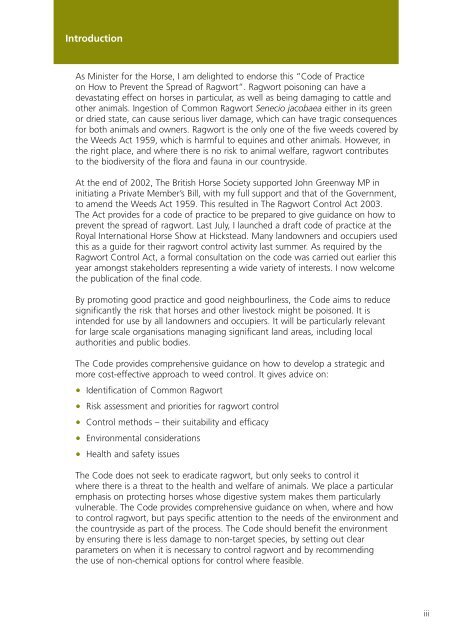code of practice on hopw to prevent the spread of ragwort - Defra
code of practice on hopw to prevent the spread of ragwort - Defra
code of practice on hopw to prevent the spread of ragwort - Defra
You also want an ePaper? Increase the reach of your titles
YUMPU automatically turns print PDFs into web optimized ePapers that Google loves.
Introducti<strong>on</strong><br />
As Minister for <strong>the</strong> Horse, I am delighted <strong>to</strong> endorse this “Code <str<strong>on</strong>g>of</str<strong>on</strong>g> Practice<br />
<strong>on</strong> How <strong>to</strong> Prevent <strong>the</strong> Spread <str<strong>on</strong>g>of</str<strong>on</strong>g> Ragwort”. Ragwort pois<strong>on</strong>ing can have a<br />
devastating effect <strong>on</strong> horses in particular, as well as being damaging <strong>to</strong> cattle and<br />
o<strong>the</strong>r animals. Ingesti<strong>on</strong> <str<strong>on</strong>g>of</str<strong>on</strong>g> Comm<strong>on</strong> Ragwort Senecio jacobaea ei<strong>the</strong>r in its green<br />
or dried state, can cause serious liver damage, which can have tragic c<strong>on</strong>sequences<br />
for both animals and owners. Ragwort is <strong>the</strong> <strong>on</strong>ly <strong>on</strong>e <str<strong>on</strong>g>of</str<strong>on</strong>g> <strong>the</strong> five weeds covered by<br />
<strong>the</strong> Weeds Act 1959, which is harmful <strong>to</strong> equines and o<strong>the</strong>r animals. However, in<br />
<strong>the</strong> right place, and where <strong>the</strong>re is no risk <strong>to</strong> animal welfare, <strong>ragwort</strong> c<strong>on</strong>tributes<br />
<strong>to</strong> <strong>the</strong> biodiversity <str<strong>on</strong>g>of</str<strong>on</strong>g> <strong>the</strong> flora and fauna in our countryside.<br />
At <strong>the</strong> end <str<strong>on</strong>g>of</str<strong>on</strong>g> 2002, The British Horse Society supported John Greenway MP in<br />
initiating a Private Member’s Bill, with my full support and that <str<strong>on</strong>g>of</str<strong>on</strong>g> <strong>the</strong> Government,<br />
<strong>to</strong> amend <strong>the</strong> Weeds Act 1959. This resulted in The Ragwort C<strong>on</strong>trol Act 2003.<br />
The Act provides for a <str<strong>on</strong>g>code</str<strong>on</strong>g> <str<strong>on</strong>g>of</str<strong>on</strong>g> <str<strong>on</strong>g>practice</str<strong>on</strong>g> <strong>to</strong> be prepared <strong>to</strong> give guidance <strong>on</strong> how <strong>to</strong><br />
<strong>prevent</strong> <strong>the</strong> <strong>spread</strong> <str<strong>on</strong>g>of</str<strong>on</strong>g> <strong>ragwort</strong>. Last July, I launched a draft <str<strong>on</strong>g>code</str<strong>on</strong>g> <str<strong>on</strong>g>of</str<strong>on</strong>g> <str<strong>on</strong>g>practice</str<strong>on</strong>g> at <strong>the</strong><br />
Royal Internati<strong>on</strong>al Horse Show at Hickstead. Many landowners and occupiers used<br />
this as a guide for <strong>the</strong>ir <strong>ragwort</strong> c<strong>on</strong>trol activity last summer. As required by <strong>the</strong><br />
Ragwort C<strong>on</strong>trol Act, a formal c<strong>on</strong>sultati<strong>on</strong> <strong>on</strong> <strong>the</strong> <str<strong>on</strong>g>code</str<strong>on</strong>g> was carried out earlier this<br />
year am<strong>on</strong>gst stakeholders representing a wide variety <str<strong>on</strong>g>of</str<strong>on</strong>g> interests. I now welcome<br />
<strong>the</strong> publicati<strong>on</strong> <str<strong>on</strong>g>of</str<strong>on</strong>g> <strong>the</strong> final <str<strong>on</strong>g>code</str<strong>on</strong>g>.<br />
By promoting good <str<strong>on</strong>g>practice</str<strong>on</strong>g> and good neighbourliness, <strong>the</strong> Code aims <strong>to</strong> reduce<br />
significantly <strong>the</strong> risk that horses and o<strong>the</strong>r lives<strong>to</strong>ck might be pois<strong>on</strong>ed. It is<br />
intended for use by all landowners and occupiers. It will be particularly relevant<br />
for large scale organisati<strong>on</strong>s managing significant land areas, including local<br />
authorities and public bodies.<br />
The Code provides comprehensive guidance <strong>on</strong> how <strong>to</strong> develop a strategic and<br />
more cost-effective approach <strong>to</strong> weed c<strong>on</strong>trol. It gives advice <strong>on</strong>:<br />
• Identificati<strong>on</strong> <str<strong>on</strong>g>of</str<strong>on</strong>g> Comm<strong>on</strong> Ragwort<br />
• Risk assessment and priorities for <strong>ragwort</strong> c<strong>on</strong>trol<br />
• C<strong>on</strong>trol methods – <strong>the</strong>ir suitability and efficacy<br />
• Envir<strong>on</strong>mental c<strong>on</strong>siderati<strong>on</strong>s<br />
• Health and safety issues<br />
The Code does not seek <strong>to</strong> eradicate <strong>ragwort</strong>, but <strong>on</strong>ly seeks <strong>to</strong> c<strong>on</strong>trol it<br />
where <strong>the</strong>re is a threat <strong>to</strong> <strong>the</strong> health and welfare <str<strong>on</strong>g>of</str<strong>on</strong>g> animals. We place a particular<br />
emphasis <strong>on</strong> protecting horses whose digestive system makes <strong>the</strong>m particularly<br />
vulnerable. The Code provides comprehensive guidance <strong>on</strong> when, where and how<br />
<strong>to</strong> c<strong>on</strong>trol <strong>ragwort</strong>, but pays specific attenti<strong>on</strong> <strong>to</strong> <strong>the</strong> needs <str<strong>on</strong>g>of</str<strong>on</strong>g> <strong>the</strong> envir<strong>on</strong>ment and<br />
<strong>the</strong> countryside as part <str<strong>on</strong>g>of</str<strong>on</strong>g> <strong>the</strong> process. The Code should benefit <strong>the</strong> envir<strong>on</strong>ment<br />
by ensuring <strong>the</strong>re is less damage <strong>to</strong> n<strong>on</strong>-target species, by setting out clear<br />
parameters <strong>on</strong> when it is necessary <strong>to</strong> c<strong>on</strong>trol <strong>ragwort</strong> and by recommending<br />
<strong>the</strong> use <str<strong>on</strong>g>of</str<strong>on</strong>g> n<strong>on</strong>-chemical opti<strong>on</strong>s for c<strong>on</strong>trol where feasible.<br />
iii
















